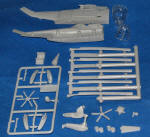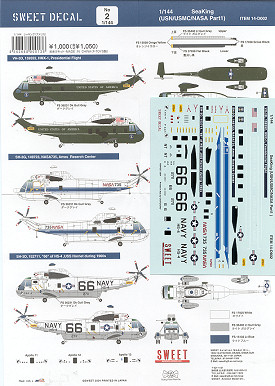In December 1957, the US Navy gave the go-ahead to a new
programme for a very high performance helicopter with advanced technology, to
replace the outdated S-58 (HSS-1). Sikorsky was approached again and submitted a
project for a big twin turbine aircraft with a boat-type hull and retractable
landing gear for amphibious operations. The aircraft had all-weather capability,
a good choice of weapons loads and four hours' endurance. The project was
designated S-61 and the HSS-2 prototype flew on 11 March 1959. The prototype was
followed by seven pre-production aircraft (YHSS-2) which successfully completed
service trials in 1960. The US Navy ordered the first ten S-61B/HSS-2 for
delivery starting in September 1961. The helicopters were later redesignated
SH-3A Sea King. One of the first production models set up a world speed record
of 339 km/h on 5 February 1962.
The main rotor of the medium-tonnage S-61 was of the
articulated type, with five interchangeable blades which could be folded
automatically by hydraulic actuators. The tail boom could also be folded for
stowage on board ship. The all-metal, semi-monocoque boat-type hull was
amphibious, the twin main wheels retracting into two sponsons. In the SH-3A
version 255 were produced, while ten more, ordered as HSS-2Z and subsequently
redesignated VH-3A, were assigned to the special American Presidential
Department for personnel transport and evacuation services in case of emergency.
Nine of the SH-3As were transformed into RH-3As with minesweeping equipment and
three were used by the USAF for missile site support and drone recovery. Another
12 SH-3As were converted into the HH-3A for battlefield rescue work, and were
fitted with two Emerson TAT-102 turrets mounted at the rear of the two sponsons,
and an in-flight refueling probe.
In April 1962, the USAF leased three HSS-2, transformed
into 27-seat transport aircraft for services linking the Texas Towers radar
installations. Another three S-61As were purchased for this purpose. Sixteen
S-61A-4s with 31 seats were acquired by the Royal Malaysian Air Force and nine
by the Danish Air Force for rescue work. In response to a Japanese naval
specification, Mitsubishi obtained a license to produce the S-61; three were
purchased directly from Sikorsky and by February 1972, 43 locally-produced
aircraft had been delivered.
From 1966, the SH-3A was superseded by the SH-3D, which
had a 1419shp T58-GE-10 turbine and new electronics. The first SH-3D delivered
in June 1966 was one of six ordered by the Spanish Navy. This was followed by
another four for the Brazilian Navy and 73 for the US Navy. The new variant was
also built under license by Agusta from 1967, following an Italian naval order
for an ASW helicopter to replace the old Sikorsky SH-34. An initial batch of 24
was built for the Italian Navy and 20 for the Iranian Navy (three in the VIP
version); the Italian SH-3D is identical to the American model, apart from the
installation of a Teledyne Doppler radar and a search radar on the left side of
the nose.
The SH-3D in USN service was upgraded to the SH-3H
variant. A non-ASW version, the SH-3G was also produced. These two types
included a more powerful engine system which required a larger horizontal
stabilizer with a support rod. This was retrofitted to many of the SH-3Ds still
in service with the reserves and training units. The last USN
versions were UH-3H's where all the ASW equipment was removed, making them quite
similar to the SH-3G.
In Britain, the Royal Navy also chose the S-61 to replace
its old Wessex. Westland acquired the license to build the SH-3 in 1959, and the
British specification called for some modifications. Thus a pair of 1521shp
Rolls-Royce Gnome H-1400 turbines were adopted, plus other British equipment
including an Ekco all-weather radar (easily recognized by the dorsal radome),
Plessey dipping sonar, Marconi Doppler navigation radar, etc.
The first British-built Sea King flew on 7 May 1969 and
the first squadrons were formed the following August. The Westland version has
completely different engines and avionics from the US versions. Westland
has built over 200 Sea Kings, including the Sea King Mk.1, 2 and 5 for the Royal
Navy, 15 for the Indian Navy (Sea King Mk.42), 22 for the German Navy (Mk.41),
11 for the Norwegian Air Force (Mk.43) and 12 for the Australian Navy (Mk.50).
Westland also designed and built a tactical helicopter called Commando, which is
directly derived from the Sea King, and the first examples flew in 1973.
Commandos have been supplied to Egypt and Qatar and, as the Sea King HC Mk.4, to
the Royal Navy.
Though now nearly gone from the USN inventory and long
gone from USAF units, the Sea King is still a very important type with many
military air arms throughout the world.
There are three markings options with
this kit. The first one is a VH-3D in gloss Olive Drab and white. There
appears to be some sort of modification to the sponsons, but thanks to the
drawings, I cannot tell what they are. You'll need a reference to properly do
this one, as it may well have been retrofitted with the larger horizontal
stab. The next one is a NASA Sea King in white with blue stripes. It is
equipped with a nose radome and while this is not specifically supplied, you
can probably modify the upper fuselage one provided for the Westland Sea
Kings. Like the previous one, this one uses the nose with the splash guard.
The final option is from HS-4 when it was used on the USS Hornet as the main
way to pick up space capsules. Though it doesn't show the ASW gear on the
sponsons, I'm sure these would be appropriate. I should also point out that
there are varous fittings on the lower fuselage and underside that may need to
be sanded off, depending on the version you are doing. I doubt if either the
NASA or '60s HS-4 aircraft would have the flare/chaff dispensers, but the
presidential helo probably would. Once again, a superbly printed sheet and
complete markings for all three variants.
 For
a more detailed look, I'll let you see the earlier
preview and will concentrate on what is different in this one. Sweet has
had these done for them in China (so what else is new). and frankly, they have
done a good job on these with one minor exception; the rescue hoist. This item
has been molded on to the right fuselage half and while it looks fairly OK,
the situation is that this thing is made from a material that is more like
vinyl than styrene. To make things worse, the mounting of it has a dedicate
For
a more detailed look, I'll let you see the earlier
preview and will concentrate on what is different in this one. Sweet has
had these done for them in China (so what else is new). and frankly, they have
done a good job on these with one minor exception; the rescue hoist. This item
has been molded on to the right fuselage half and while it looks fairly OK,
the situation is that this thing is made from a material that is more like
vinyl than styrene. To make things worse, the mounting of it has a dedicate d
sink area that refuses any known fillers. The stuff won't stick to it. You are
pretty well stuck with it unless you wish to remove it totally and
scratch-build a hoist and bracing assembly, not an easy task in 1/144.
d
sink area that refuses any known fillers. The stuff won't stick to it. You are
pretty well stuck with it unless you wish to remove it totally and
scratch-build a hoist and bracing assembly, not an easy task in 1/144.